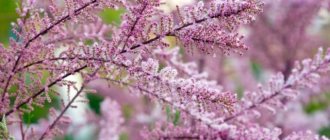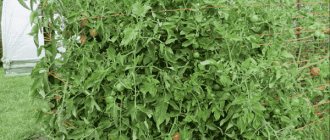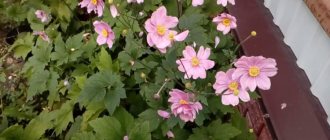Montbretia flowers (crocosmia) are still rarely grown in summer cottages. These perennial corms, like acidantheras, of the Iris family, which also have a third name - Japanese gladiolus, attract attention with their graceful paniculate inflorescences, which are located on long, thin peduncles. Their length is about 1 m. This plant is somewhat reminiscent of miniature gladioli, which is why Montbrecia got its popular name. It has decorative not only bell-shaped flowers, but also narrow sword-shaped dark green leaves, the length of which reaches 60 cm.
Characteristics of flowers
The Montbretia flower, also called crocosmia or mambrecia, belongs to the iris family. Its name comes from the Greek language, in which it means “saffron and smell.” The plant is native to South Africa. The main distinguishing characteristic of Montbrecia is its bright orange, red and yellow flowers, which are similar in shape to a sword. Many species of Montbretia have been developed from South African wild varieties, differing in size and flowering period. All these species are united by the fact that they are very resistant to various external conditions. This flower is evergreen, and its leaves are long and elongated, and they can be straight or wavy. Thanks to its beautiful large leaves, crocosmia decorates gardens even before it begins to bloom.
Particularly noteworthy are the roots of Montbretia, which are shaped like chains and intertwine neighboring plants. As the plant grows, its roots can spread over large areas, so it can often be difficult to remove and can interfere with the growth of other species that are in the flower bed nearby. This means that for planting, Montbretia flowers (see photo above) require significant space in the garden.
Diseases and pests
Fusarium (manifests itself in different ways and has several names: drying out, yellowing of gladiolus, core rot, dry rot). Fusarium blight is most characterized by yellowing of the leaf tips, which progresses before or during flowering. Yellowness spreads between the veins, the leaves become striped, turn brown and die. With severe damage, the entire plant dries out. Fungal spores penetrate the vessels of the roots and the corm. Plants are easily pulled out of the soil.
In infected plants, the shape, size and color of the flower changes, the leaves and peduncles become bent. The baby is almost not formed. The affected bulbs darken and wrinkle. More often the defeat begins from the bottom. The development of fusarium is promoted by both drought and excessive humidity, dense plantings and violations of agricultural practices.
Herbaceousness, or jaundice. When gladiolus is infected early, the disease manifests itself in yellowing of the tips of the leaves, which gradually spreads to the entire plant. The leaves become straw-yellow and the plant dies prematurely. With lesions at a later date, no external signs of the disease are observed. By the time of planting, many buds appear on an apparently healthy bulb. After planting, chlorotic thread-like shoots are formed. These shoots do not develop and die after a while. The bulb becomes hard and remains in the soil for a long time without rotting.
The disease is transmitted by cicadas. Heat treatment of slightly affected bulbs at a temperature of 45°C for 15-20 minutes completely destroys the pathogen.
Thrips is a small sucking insect with an elongated body (its length is 1-1.5 mm). Thrips parasitize gladioli both during their growth and during storage. Sometimes during flowering, thrips infects the flowers so much that they are unable to bloom. Larvae and adult insects, piercing tissues, suck juice from leaves, flowers and bulbs.
At temperatures below +12°C, thrips go under the covering scales of the bulbs and overwinter there. In winter, bulbs affected by thrips become covered with a sticky coating of juice and become mummified. When severely damaged, they do not germinate.
The mole cricket is an insect up to 5 cm long, dark brown in color with a chitinous coating. The mole cricket damages the roots, bulbs and stems of gladioli. It most often settles on moist soils, near water bodies, on peat bogs and soils rich in humus. Leads a mainly underground lifestyle.
Those who decide to grow Montbrecia will be amazed by the beauty and grace of this flower and will become its constant adherents. And the appearance of montbretia on the flower market will bring true pleasure to lovers and connoisseurs of beauty.
Flowering plant
Bright red, orange and yellow mambrecia flowers appear in May-June, but the plant continues to bloom until mid-autumn, forming more and more buds. This feature of flowers is very useful for their use as garden decoration throughout the hot period of the year.
Flowers appear on tall stems, which can reach a height of 60 cm. Up to 20 flowers can appear on one stem during the entire flowering period of Montbretia. Often, gardeners cut stems with flowers to make a magnificent bouquet of them that exudes a pleasant scent, and put it in a vase to decorate the home interior. An interesting feature of flowers is that as they dry, the scent they emit intensifies.
Montbrezia, aka crocosmia, aka...
In its habitat there are more than 55 species of crocosmia - this is the Latin designation for wild varieties of the plant, while the garden form is called montbretia. Both terms are used in floriculture. There are other names in everyday life - in Europe it was called tritonia (weathervane), in our country - Japanese or Chinese gladiolus montbretia.
At the beginning of the growing season, the corm perennial shoots out a stem with many long and narrow sword-shaped leaves, like those of a gladiolus. Next, it throws out a strongly branching flower arrow, which is longer than the leaves and reaches, depending on the variety, 60–120 cm. In the second half of summer, up to 10 tubular flowers bloom in turn on each branch of the peduncle, the decorative nature of which remains until the end of September. The predominant color is orange and its fiery shades.
Initially, small-flowered varieties of traditional orange color became widespread in floriculture. In recent years, bulbs of hybrids of Montbretia grandiflora with flowers not only golden, but also red, salmon-pink, and yellow have appeared on sale.
This is interesting! The consonance of the name of the perennial with crocus is not accidental. They are united by the aroma of saffron (in Greek “crocos”), which the plant emits during flowering and after the peduncle has dried.
Brief overview of the main types
There are about 400 different varieties of Montbrecia flowers. Below are just the most common ones:
- Lucifer. This variety of red crocosmia was bred in the 60s of the last century. It is relatively easy to care for as it only needs good sunlight and moderate watering. Lucifer begins to bloom its bright red buds in mid-July.
- Severn Sunrise. This variety is practically no different from the previous one in terms of care. Its flowers have orange-red hues and are yellow inside. This coloring gives the flowers a great look. With proper care, these flowers grow up to 90 cm.
- Carmine Diamond. Judging by the name, you can guess that the Montbrecia flower of this variety is distinguished by its rich red-carmine flowers. Unlike other varieties of crocosmia, Carmine Diamond is a relatively small plant (up to 60 cm), but it is resistant to various diseases and pests.
- Emily McKenzie. This variety is similar in many of its characteristics to Carmine Brilliant; it is also low (up to 60 cm) and also does not require special care measures; in addition, McKenzie is a frost-resistant variety. It is characterized by bright orange flowers.
- Star of the East. The advantages of this variety are its large orange flowers, which reach 10 cm in diameter, as well as a long flowering period. The disadvantages include the fact that in order to successfully grow a plant, it is necessary to carry out certain care measures, otherwise the plant may die from exposure to pests or winter frosts. A photo of a Montbrecia flower of this variety is shown below.
Description, morphological characteristics
Crocosmia (abbreviated from Greek crocosmia - the smell of saffron) is a genus of garden South African hybrids of the iris family, corms of perennials. The most famous representatives of the South African genus are Montbretia crocosmiaceae and Montbretia garden, bred in 1880 by the French breeder Lemunan.
Externally, crocosmia resembles a miniature gladiolus. Majestic long peduncles emerge from the basal rosette of sword-shaped narrow leaves. The branched stems are thin, graceful, slightly bending, up to a meter high. The paniculate type inflorescences bear 5-10 funnel-shaped or star-shaped flowers with diverging graceful petals.
Flowers open from bottom to top almost simultaneously. Their size is small, only 3-5 cm in diameter, and their color is a variation of red-orange, red-pink. Dried crocosmia flowers smell like saffron, justifying the Greek name.
Montbrecia flowering
The corms of the plant are turnip-shaped, with 2-3 layers of mesh shell. A corm with a bottom diameter of 2.5-3 cm produces 2-4 peduncles. Montbrecia blooms later - from July to September. All its beauty can be appreciated in the photos of common varieties.
General requirements for growing a plant
When considering the issue of planting montbretia and caring for it in open ground, it should be noted that these flowers need good lighting. The more sunlight falls on a flowerbed with montbretia, the healthier and taller it will grow, and the brighter and more magnificent its flowering will be.
In addition to plenty of light, the Montbretia flower also needs fertile soil and abundant summer rains, after which it will bloom until late autumn. The soil must contain a sufficient amount of humus and have good drainage.
If the conditions described above are met, the growth of flowers can be excessive, and they fill the space given to them with a dense and thick blanket.
Description and types
The plant is sometimes also called "Japanese gladiolus", for its some external resemblance to this bulbous plant. Montbrecia has very decorative flowers, shaped like lilies. But, unlike lilies, in this case the flowers are small and are collected in inflorescence groups.
The plant can reach a height of one and a half meters: but this is in its natural habitat, in its native tropics. In cool climates, the plant reaches a height of 40 cm to a meter.
The specifics of its cultivation are almost similar to the gladiolus flower, so for most gardeners it will not cause any difficulties.
The plant is a relative of saffron, crocus, iris, snowdrop, freesia and gladiolus, resembling all of them at the same time. Montbrecia looks ideal in open flower beds in a general composition with plants such as lily, echinacea, canna, and salvia. The tropical beauty also behaves well when cut: it can stand well in water after being separated from the mother bush for up to two weeks.
Read the material about planting freesia, as well as about caring for and growing crocuses.
How to plant crocosmia?
If we talk about caring for and planting montbretia in open ground, it should be noted that there are two ways to propagate these flowers:
- using seeds;
- by dividing the bulbs.
The difference between these planting methods is that plants planted with bulbs grow faster and begin to bloom earlier than those planted with seeds.
Bulbs should be planted in early spring. The bulbs should be planted at a depth of about 10 cm.
If planting is carried out by seeds, then they are planted in late spring. There are two ways:
- when planting in open ground, it is recommended to plant seeds at the same depth as the bulbs, that is, 10 cm;
- When planting in a flower pot, the seeds must be placed in the substrate to a depth of only 2 cm.
The soil for planting should be well loosened and have average fertility. After completing the planting process, the soil should be watered with a moderate amount of water. Good drainage properties of the soil guarantee that water after watering will be completely absorbed and will not stagnate in puddles, since the latter leads to rotting of the plant roots within a few days.
It is also necessary to keep in mind that any type of crocosmia grows strongly and intertwines, therefore, in order to maintain a flower bed with a plant in a healthy flowering state, it is necessary to dig up, separate and plant its bulbs every 3-4 years in early spring.
Growing from seeds
It is easier to grow a plant from seeds if you use the seeding method. For this purpose, prepare containers with soil, which should include peat, sand, turf, and humus. Seeds should be soaked for a day before sowing. For disinfection, you can use a weak solution of potassium permanganate for soaking. After sowing, cover the container with film and place it in a warm, well-lit place.
Which place to plant Montbrecia should I choose?
As mentioned above, mambretia flowers of any variety are light-loving, which means that the planting site should be illuminated by the sun most of the day.
Another important point that needs to be paid attention to is the drainage properties of the soil. In order to understand whether the chosen planting site has good drainage or not, you need to observe it after heavy rain. If within 5-6 hours after rain there are no puddles left on the soil surface, then this place is suitable for planting montbretia. Otherwise, it is recommended to modify the soil of the selected location by adding fertilizers based on peat and humus.
Plant care in spring and summer
Every beginner in gardening who wants to decorate the space around their home with magnificent flowers is recommended to plant crocosmia flowers, since they require virtually no care.
Speaking about planting montbretia and caring for it in the open ground, it should be noted that in the spring-summer period of the year after planting the seeds of these plants, you only need to ensure that the soil in the flowerbed does not dry out completely. As soon as this happens, you should water the plants with a moderate amount of water. Note that watering should not be frequent, since Montbretia bulbs are very sensitive to excess moisture and can quickly rot.
Throughout the summer and especially during the flowering period, fertilizers must be applied. This should be done once every 3 weeks during watering. It is preferable that the fertilizer be organic, for example, based on humus. You can prepare this fertilizer yourself in advance.
Shrub crocosmia: combination with other plants
Crocosmia goes well with tall, perennial flowering crops: rudbeckia, popovnik, Rogersia, catnip, speedwell. A mixborder of perennials in landscape design, in which crocosmia is often planted, pleases the eye with the splendor of flowering all summer long, because, with the abundance of modern varieties, it is always possible to choose flowers with bright colors and different flowering periods.
Crocosmia makes an excellent combination with perennial grasses and daylilies.
Caring for Montbrecia in the autumn-winter period
The issue of planting montbretia and caring for it in open ground also involves taking some measures when the plants stop blooming, that is, in late autumn. Care activities include the following:
- It is necessary to loosen the top layer of soil in the flowerbed and add some organic fertilizer to it.
- In areas with cold winters, it is recommended to cover the flower bed. To do this, you can use various materials, for example, sawdust, dry pine needles or small straw.
Reviews from flower growers
For flower growers in Eastern Europe, crocosmia has not yet become a familiar flower, due to the paucity of information and knowledge on how to care for it. But increasingly, Japanese gladiolus is becoming a bright decoration of garden areas, ridges, and alpine slides. Those who have hosted a European guest note the extraordinary beauty of group plantings, original bouquets, and the opportunity to use dry plants in room design.
Disadvantages include the poor cold resistance of some varieties and the need to dig them up for the winter.
We invite you to read: Growing cucumbers in a greenhouse in winter: diagram
Some tips for growing Montbrecia
If you can’t find a sunny place, then planting mambrecia flowers (photo above) can be done in a semi-shady place, for example, in the shade of some other plant in the garden. In this case, the plant creating shade will provide the soil moisture necessary for the growth of the montbretia.
In case of very cold winters, it is recommended to dig up the plant bulbs and bring them indoors to preserve them. The bulbs must be placed in a box with sawdust and placed in a dark place with an air temperature of 5-7 °C. From time to time, you should slightly moisten the sawdust and put the bulbs in them again. In this way, you can preserve the bulbs until the time of planting, that is, until the beginning of spring.











